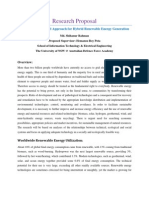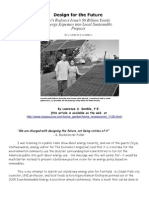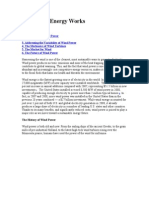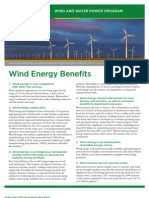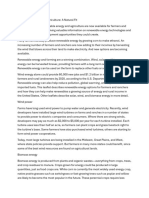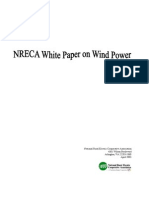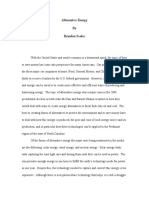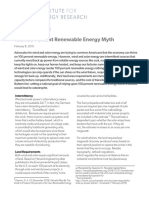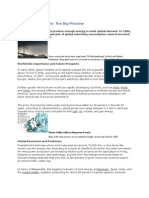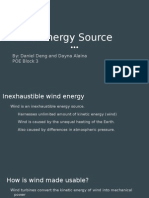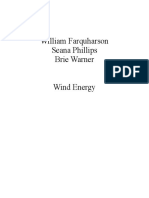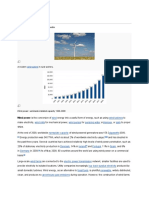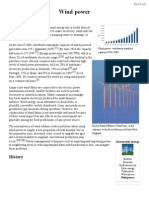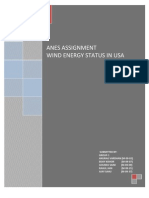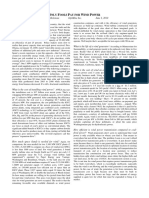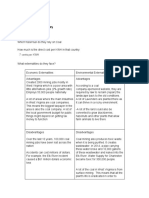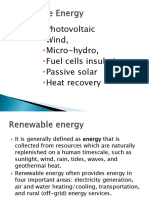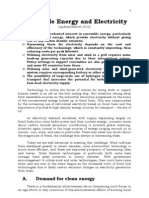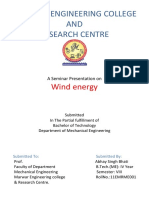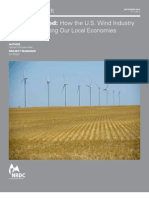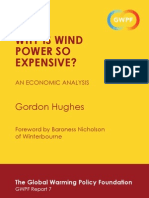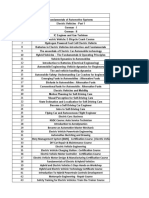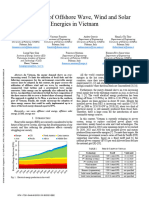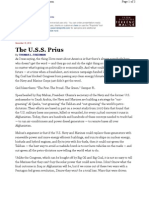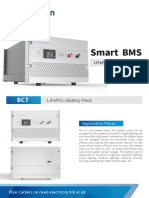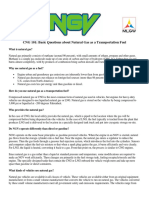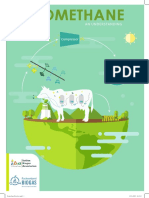Wpa Factsheet Series PDF
Wpa Factsheet Series PDF
Uploaded by
Balan PalaniappanCopyright:
Available Formats
Wpa Factsheet Series PDF
Wpa Factsheet Series PDF
Uploaded by
Balan PalaniappanOriginal Description:
Original Title
Copyright
Available Formats
Share this document
Did you find this document useful?
Is this content inappropriate?
Copyright:
Available Formats
Wpa Factsheet Series PDF
Wpa Factsheet Series PDF
Uploaded by
Balan PalaniappanCopyright:
Available Formats
Wind Energy Benefits
Wind Powering America Fact Sheet Series
Wind Energy Benefits
2
Wind energy is a valuable crop of the future for farmers and ranchers. Wind farms located in rural areas generate energy that can be transmitted to load centers in urban areas via the regional utility grid. The rural areas retain the jobs, as well as land lease revenue for farmers and ranchers (as much as $4000 per turbine per year). Wind turbines are compatible with rural land usescrops can be grown and livestock can be grazed up to the base of the turbine.2 Wind energy also provides an increased local tax base for rural areas. Prowers County, home to the Lamar project, increased its local tax base by $32 million.3 The 912 MW of new wind power installed in Texas in 2001 will deliver $13.3 million in tax revenue for schools and counties.4
Wind energy is economically competitive. With todays rising coal and gas prices, new wind plants compete favorably against any new electricity generation source. In fact, when the Colorado Public Service Commission issued a ruling on the 161-megawatt (MW) wind project in Lamar, Colorado, the commission determined that wind energy provided the lowest cost of any generation resource submitted to a solicitation bid by Xcel Energy. The commission also noted that unlike the other generation resources considered, the Lamar project avoided a future risk of increased fuel prices.1
GE Wind Energy All Rights Reserved/PIX13728
3 4
Unlike most other electricity generation sources, wind turbines dont consume water. Irrigation and thermal electric generation account for approximately 77% of U.S. fresh water use. Conventional plants generating power from fossil and nuclear fuels use large amounts of water for cooling; wind turbines do not use water.5 That makes wind energy a great choice for drought-stricken communities in rural America. Wind energy is an indigenous, homegrown energy source that contributes to national security. The United States is the worlds largest importer of oil and natural gas, which often originate in troubled areas of the world. The Great Plains region, which has been dubbed the Saudi Arabia of wind because of its tremendous untapped wind energy potential, offers homegrown energy, which increases national security. Reliance on indigenous resources also reduces the balance of payments that threatens our national economic security. Because of the distributed aspect of wind energy, it is less vulnerable than large liquefied natural gas (LNG) ports or large thermoelectric power plants.
Wind turbines are compatible with rural land uses. Crops can be grown and livestock can be grazed up to the base of the turbine.
GE Wind Energy All Rights Reserved/PIX12334
5 6
Wind energy is inexhaustible and infinitely renewable. Unlike conventional fossil fuels, wind energy is renewable, abundant energy that will be available for future generations. Wind energy has many environmental benefits. Wind energy is clean energy that produces no emissions, which means it doesnt contribute to acid rain and snow, global climate change, smog, regional haze, mercury contamination, water withdrawal, and particulate-related health effects.
Because wind energys fuel is free, it reduces the risk Wind energy provides 40-160 construction jobs and Wind farms, such as the Brazos Wind Ranch in Texas 10-25 operations and maintenance jobs per 100 MW. pictured here, provide new jobs, tax revenue, and associated with volatile fossil fuel landowner income. prices. Wind displaces electricity that energy to power their homes or businesses. Xcel Energys Windsource, would otherwise be produced by burning natural gas, thus helping the largest customer-driven wind energy program in the nation (more to reduce gas demand and limit gas price hikes. According to the than 30,000 participants), experienced 30% annual growth from American Wind Energy Association, the current U.S. gas shortage 1998 to 2003. Deliberative public polling in Texas7 and Nebraska8 amounts to approximately 3 to 4 billion cubic feet (Bcf) per day. By the demonstrated overwhelming support of wind energy as an element of end of 2004, wind plants were generating about 17 billion kilowattthe generation portfolio. Because customers want wind as a portion of hours (kWh) annually, or the equivalent of nearly 0.5 Bcf/day of natural 6 their electricity portfolio, more than 300 utilities currently offer green gas. In most areas of the country, every kilowatt-hour of electricity produced by wind power helps reduce the demand for natural gas used pricing programs that include wind energy. to generate electricity. Lower demand for natural gas helps mitigate rising costs of consumer heating and electricity, industrial processes, and chemical and agricultural feedstocks. _____________
1 www.eere.energy.gov/windandhydro/windpoweringamerica/pdfs/xcel_wind_
8 9
decision.pdf
2 www.eere.energy.gov/windandhydro/windpoweringamerica/pdfs/wpa/
Wind energy is the fuel of today and tomorrow. Today, wind provides competitive electricity. Tomorrow, it is likely to be the cheapest source of electricity for the distributed generation of hydrogen. Wind energy can be used in a variety of applications. Small wind turbines, alone or as part of a hybrid system, can power homes, businesses, and farms/ranches. Wind energy is perfect for remote applications, such as water pumping, ice making, powering telecommunications sites, and displacing diesel fuel in villages. Community wind projects include projects for schools, tribes, municipal utilities, and rural electric cooperatives.
33590_econ_dev.pdf
3 Personal communication, John Stulp, Prowers County Commissioner, Jan. 10,
2005
4 www.citizen.org/documents/Tx%20Energy%20Powerhouse.pdf 5 www.catf.us/publications/reports/The_Last_Straw.pdf 6 www.awea.org/newsroom/Wind%20Energy%20Basics%20-%202005-
0406.pdf
7 www.eere.energy.gov/windandhydro/windpoweringamerica/pdfs/33177_
tx.pdf
8 www.eere.energy.gov/windandhydro/windpoweringamerica/filter_
detail.asp?itemid=700
10
The people want wind energy. Because of all the reasons listed above, along with concern over debilitating illnesses associated with air pollutants, wind has overwhelming public support. Many people express their support by purchasing blocks of wind
DOE/GO-102005-2123 April 2005 A Strong Energy Portfolio for a Strong America Energy efficiency and clean, renewable energy will mean a stronger economy, a cleaner environment, and greater energy independence for America. Working with a wide array of state, community, industry, and university partners, the U.S. Department of Energys Office of Energy Efficiency and Renewable Energy invests in a diverse portfolio of energy technologies. Produced for the U.S. Department of Energy by the National Renewable Energy Laboratory, a DOE national laboratory
Printed with a renewable-source ink on paper containing at least 50% wastepaper, including 20% postconsumer waste
For more information contact: EERE Information Center 1-877-EERE-INF (1-877-337-3463) www.eere.energy.gov
D. A. Black/PIX12866
You might also like
- Elgi Airlube XDDocument1 pageElgi Airlube XDANILNo ratings yet
- The Advantages and Disadvantages of Renewable Energy RMDocument6 pagesThe Advantages and Disadvantages of Renewable Energy RMBing Perez CuetoNo ratings yet
- Research Proposal ADFA ShihanDocument7 pagesResearch Proposal ADFA ShihanM Riyadh SharifNo ratings yet
- 1 Malvinas Training BookletDocument71 pages1 Malvinas Training BookletJessica Cristina Navarro Ravelo50% (2)
- Agrogas ProjectDocument6 pagesAgrogas ProjectpipestressNo ratings yet
- Wind Energy's Overblown ProjectDocument4 pagesWind Energy's Overblown ProjectR. Iwan BudhiartaNo ratings yet
- Source Community EnergyDocument7 pagesSource Community EnergyLonnie GambleNo ratings yet
- Wind EnergyDocument5 pagesWind Energylorena gartisaniNo ratings yet
- How Does Wind Energy WorksDocument11 pagesHow Does Wind Energy WorksVasu NaikNo ratings yet
- Wind Energy Benefits: Wind and Water Power ProgramDocument2 pagesWind Energy Benefits: Wind and Water Power ProgramBalan PalaniappanNo ratings yet
- essayDocument2 pagesessaysavippkNo ratings yet
- Whitepaper On Wind PowerDocument78 pagesWhitepaper On Wind Powersebascian100% (1)
- Wind Power PDFDocument3 pagesWind Power PDFBalan PalaniappanNo ratings yet
- The Economics of Wind PowerDocument11 pagesThe Economics of Wind PowerG ChandrasekaranNo ratings yet
- Wind Energy Fact SheetDocument2 pagesWind Energy Fact SheetJeferson Tondo AlvesNo ratings yet
- Fu 1Document10 pagesFu 1Ismeta VarupaNo ratings yet
- Assignment #3Document4 pagesAssignment #3musaNo ratings yet
- H&S ProjectDocument30 pagesH&S ProjectDev ParekhNo ratings yet
- WWW Sciencealert Com Why Are Millions of People in Texas WitDocument7 pagesWWW Sciencealert Com Why Are Millions of People in Texas Witkim haroldNo ratings yet
- Mini Project Wind EnergyDocument12 pagesMini Project Wind EnergyGaurav SinghNo ratings yet
- Alternative Energy PaperDocument6 pagesAlternative Energy PaperBrandon ScalesNo ratings yet
- Renewable Myth Policy Brief219Document5 pagesRenewable Myth Policy Brief219ak7642840No ratings yet
- Wind Energy ProfileDocument2 pagesWind Energy Profilesidhant1546No ratings yet
- Review of Related Literature and StudiesDocument10 pagesReview of Related Literature and StudiesCastle GelynNo ratings yet
- Engineering Alternative Energy-Wind and Solar Power Systems-4Document1 pageEngineering Alternative Energy-Wind and Solar Power Systems-4Antar AbdalaNo ratings yet
- North Wind Energy in North Dakota: A Feasible Energy Source?Document3 pagesNorth Wind Energy in North Dakota: A Feasible Energy Source?Umer PrinceNo ratings yet
- Wind Energy PresentationDocument12 pagesWind Energy Presentationapi-302369625No ratings yet
- Bs Bab 6Document12 pagesBs Bab 6A-Meen HadiNo ratings yet
- Wind EnerdyDocument7 pagesWind Enerdyapi-312373593No ratings yet
- Wind Power: From Wikipedia, The Free EncyclopediaDocument26 pagesWind Power: From Wikipedia, The Free EncyclopediaVivek JumdeNo ratings yet
- Electric 07Document10 pagesElectric 07Nicholas WhiteNo ratings yet
- Wind PowerDocument13 pagesWind PowerSatheesh PrabuNo ratings yet
- Wind2016Document21 pagesWind2016Micro YuchenNo ratings yet
- Wind Power:: 20 Myths Blown AwayDocument12 pagesWind Power:: 20 Myths Blown AwayBalan PalaniappanNo ratings yet
- Final Offshore Wind ReportDocument13 pagesFinal Offshore Wind Reportapi-339751497No ratings yet
- RES 6TH SEM EEDocument162 pagesRES 6TH SEM EEBharath rajuNo ratings yet
- Anes Assignment-Group 1Document6 pagesAnes Assignment-Group 1Gourav SainiNo ratings yet
- I. History: Blyth's "Windmill" at His Cottage in Marykirk in 1891Document7 pagesI. History: Blyth's "Windmill" at His Cottage in Marykirk in 1891Цедіе РамосNo ratings yet
- Boleneus 2010 BDocument2 pagesBoleneus 2010 BBisto MasiloNo ratings yet
- SEN Weekly NewsDocument14 pagesSEN Weekly NewsBareBearNo ratings yet
- Full ScriptDocument9 pagesFull Scriptngobchau422005No ratings yet
- Renewable EnergyDocument56 pagesRenewable EnergyRana Muhammad TalhaNo ratings yet
- Wind Turbines in CaliforniaDocument4 pagesWind Turbines in CaliforniaEdgar FigueroaNo ratings yet
- Renewable Sources of EnergyDocument5 pagesRenewable Sources of EnergyNandini MehraNo ratings yet
- The Most Frequently Asked Questions About Wind Energy (Circa 2001-2004)Document30 pagesThe Most Frequently Asked Questions About Wind Energy (Circa 2001-2004)ramnadh803181No ratings yet
- What Are The Solutions To Climate ChangeDocument61 pagesWhat Are The Solutions To Climate ChangearunkumarchikkopNo ratings yet
- Ielts Academic Reading Practice Test 5 7be37aa00fDocument4 pagesIelts Academic Reading Practice Test 5 7be37aa00fJohnNo ratings yet
- Sample ReportDocument5 pagesSample Reportapi-429837613No ratings yet
- Benefits of Geothermal EnergyDocument4 pagesBenefits of Geothermal EnergyIntan Nur AmaliaNo ratings yet
- Photovoltaic Wind, Micro-Hydro, Fuel Cells Insulation, Passive Solar Heat RecoveryDocument17 pagesPhotovoltaic Wind, Micro-Hydro, Fuel Cells Insulation, Passive Solar Heat RecoveryKhiZra ShahZadNo ratings yet
- Renewable Energy and Electricity-55hDocument55 pagesRenewable Energy and Electricity-55hsenoooooo100% (1)
- Renewable Energy Shayona 6 - eDocument3 pagesRenewable Energy Shayona 6 - eshanjoshylin1234No ratings yet
- EAPP ReportDocument23 pagesEAPP ReportSemi SenNo ratings yet
- 306 Electricity Supply IndustryDocument8 pages306 Electricity Supply IndustryMani KandanNo ratings yet
- Barriers To Large-Scale Renewable Energy Generation: Bryan Leyland MSC, Fimeche, FipenzDocument6 pagesBarriers To Large-Scale Renewable Energy Generation: Bryan Leyland MSC, Fimeche, Fipenzanon_462491No ratings yet
- MN Wind PowerDocument8 pagesMN Wind Powertaner56No ratings yet
- ReportDocument47 pagesReportmayank911No ratings yet
- Solar Power Plant ReportDocument28 pagesSolar Power Plant ReportsolankijaxNo ratings yet
- Project Report 31Document21 pagesProject Report 31Junaid YNo ratings yet
- Harness the Sun: America's Quest for a Solar-Powered FutureFrom EverandHarness the Sun: America's Quest for a Solar-Powered FutureRating: 3.5 out of 5 stars3.5/5 (38)
- Chinese Lesson1Document8 pagesChinese Lesson1Balan PalaniappanNo ratings yet
- Wind Energy Development in The Caribbean: Raymond M. WrightDocument6 pagesWind Energy Development in The Caribbean: Raymond M. WrightSaravana KumarNo ratings yet
- International Review of Wind Policies and RecommendationsDocument43 pagesInternational Review of Wind Policies and RecommendationsbluesbankyNo ratings yet
- RERL Fact Sheet 2a Capacity FactorDocument4 pagesRERL Fact Sheet 2a Capacity FactorAbdullah KaymakcıNo ratings yet
- Wind Power:: 20 Myths Blown AwayDocument12 pagesWind Power:: 20 Myths Blown AwayBalan PalaniappanNo ratings yet
- File Down Load, 1633, enDocument119 pagesFile Down Load, 1633, enDomenico VerbicaroNo ratings yet
- Wind Energy - The Case of DenmarkDocument39 pagesWind Energy - The Case of DenmarkletvineyardersdecideNo ratings yet
- Wind Communities Ib PDFDocument16 pagesWind Communities Ib PDFBalan PalaniappanNo ratings yet
- Active Load Control Techniques For Wind Turbines: Sandia ReportDocument132 pagesActive Load Control Techniques For Wind Turbines: Sandia ReportBalan PalaniappanNo ratings yet
- 0035 PDFDocument8 pages0035 PDFBalan PalaniappanNo ratings yet
- Wind Power PDFDocument3 pagesWind Power PDFBalan PalaniappanNo ratings yet
- Wind FactsDocument16 pagesWind Factsbiotech_vidhyaNo ratings yet
- Pure Power Full Report PDFDocument78 pagesPure Power Full Report PDFBalan PalaniappanNo ratings yet
- Wind Power:: 20 Myths Blown AwayDocument12 pagesWind Power:: 20 Myths Blown AwayBalan PalaniappanNo ratings yet
- Hughes Windpower PDFDocument44 pagesHughes Windpower PDFBalan Palaniappan100% (1)
- Common Concerns About Wind Power: Centre For Sustainable Energy, May 2011Document40 pagesCommon Concerns About Wind Power: Centre For Sustainable Energy, May 2011Balan PalaniappanNo ratings yet
- SatWindPot2012 PDFDocument14 pagesSatWindPot2012 PDFBalan PalaniappanNo ratings yet
- Pengenalan Energi Terbarukan: Dipl.-Ing. Daniel Pianka Universitas Kristen ImmanuelDocument18 pagesPengenalan Energi Terbarukan: Dipl.-Ing. Daniel Pianka Universitas Kristen ImmanuelClaudya Stephanie Angeline Harman 1841100208No ratings yet
- Sustainable Practices in Eco-Friendly HotelsDocument17 pagesSustainable Practices in Eco-Friendly HotelsgurbaazjassuNo ratings yet
- Automobile Self Learning CourseDocument6 pagesAutomobile Self Learning CourseBashir Mojbar100% (1)
- Science EssayDocument5 pagesScience Essayapi-288115844No ratings yet
- Techno-Economic Analysis of Solar Photovoltaic PowDocument8 pagesTechno-Economic Analysis of Solar Photovoltaic PowrabiNo ratings yet
- Region 1Document20 pagesRegion 1Marlon EvangelistaNo ratings yet
- Regulation and Planning of District Heating in DenmarkDocument28 pagesRegulation and Planning of District Heating in Denmarkbodokoplo2000No ratings yet
- Steam Gasification of Biomass With Subsequent Syngas Adjustment Using Shift Reaction For Syngas Production - An Aspen Plus Model PDFDocument9 pagesSteam Gasification of Biomass With Subsequent Syngas Adjustment Using Shift Reaction For Syngas Production - An Aspen Plus Model PDFSuprio KamalNo ratings yet
- Introduction To LEED PDFDocument11 pagesIntroduction To LEED PDFEngSafwanQadousNo ratings yet
- 2021 - Introduction of Offshore Wave, Wind and Solar Energies in Vietnam - PublicationDocument10 pages2021 - Introduction of Offshore Wave, Wind and Solar Energies in Vietnam - PublicationLe HangNo ratings yet
- Klirou ProjectDocument15 pagesKlirou ProjectMaryam AsadNo ratings yet
- Solarquarter: The Plant Features FIMER PVS980 1MW Central Inverter and A PVS980-BC 2MW Energy Storage InverterDocument4 pagesSolarquarter: The Plant Features FIMER PVS980 1MW Central Inverter and A PVS980-BC 2MW Energy Storage InverterDeepak GehlotNo ratings yet
- 555W Datasheet - Vertex - DE19 - EN - 2020 - PA1 - WebDocument2 pages555W Datasheet - Vertex - DE19 - EN - 2020 - PA1 - WebAlexander BrionesNo ratings yet
- GA15 22 Principal DataDocument5 pagesGA15 22 Principal Datajaypc10No ratings yet
- Fried Mango Green NavyDocument3 pagesFried Mango Green NavycaritowebNo ratings yet
- Weeks 9&10 - Combined Cycle Power Plant & Cogeneration 1T 2022-2023Document66 pagesWeeks 9&10 - Combined Cycle Power Plant & Cogeneration 1T 2022-2023Chris LlamosoNo ratings yet
- Data Sheet of 48v Lithium Ion BatteryDocument8 pagesData Sheet of 48v Lithium Ion BatteryMC Sai ThihaNo ratings yet
- CNG 101: Basic Questions About Natural Gas As A Transportation FuelDocument2 pagesCNG 101: Basic Questions About Natural Gas As A Transportation FuelPawan ChaturvediNo ratings yet
- Dire Dawa UniversityDocument15 pagesDire Dawa UniversityBarkhad MohamedNo ratings yet
- Gas Power CycleDocument14 pagesGas Power CycleAvinash chevalaNo ratings yet
- Flyer - PUMY Series 2023Document8 pagesFlyer - PUMY Series 2023lio mareNo ratings yet
- Syngas Cleaning For Coal To Methanol Demo Plant - H S and COS RemovalDocument16 pagesSyngas Cleaning For Coal To Methanol Demo Plant - H S and COS RemovalАлексей МинькоNo ratings yet
- Literature Review BiodieselDocument4 pagesLiterature Review Biodieselgw1sj1yb100% (1)
- HS SeriesDocument4 pagesHS Series潘学淼No ratings yet
- Biomethane Brochure 1684039067Document64 pagesBiomethane Brochure 1684039067Prakash GanjalliNo ratings yet
- Uop-Twister-Supersonic-Gas-Separation-System1.pdf - Feed Pressure PDFDocument2 pagesUop-Twister-Supersonic-Gas-Separation-System1.pdf - Feed Pressure PDFmofiyinfoluNo ratings yet
- Is A Variable Speed Drive (VSD) Compressor The Right Choice For Your Facility?Document3 pagesIs A Variable Speed Drive (VSD) Compressor The Right Choice For Your Facility?Ahmad DeyabNo ratings yet


